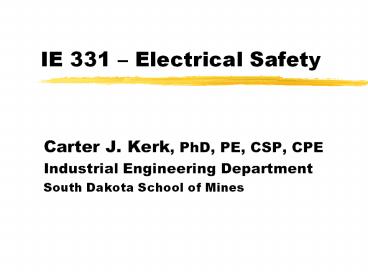IE 331 - PowerPoint PPT Presentation
Title:
IE 331
Description:
Damage sensitive electrical and computer equipment. Other Issues. Lightning. Battery Charging ... National Electrical Code has established a classification system ... – PowerPoint PPT presentation
Number of Views:551
Avg rating:3.0/5.0
Title: IE 331
1
IE 331 Electrical Safety
- Carter J. Kerk, PhD, PE, CSP, CPE
- Industrial Engineering Department
- South Dakota School of Mines
2
Introduction
- Read Chapter 12
- HW12, Review Questions, p. 175, odds
3
Is Electrical Safety Important?
- 11 of OSHA general industry citations address
electrical hazards - Improper grounding
- Ungrounded tools
- Portable tools in damp/wet locations
- Ground pin broken off
- Exposed live parts
- Sloppy electrical installations
- Breaker box open
4
Raise your hand
- Have you ever received a shock from a 110V
circuit? - Does anyone have any good stories to tell?
- Is there anyone present who has not received such
a shock?
5
Can a 110V circuit kill?
- Myth Ordinary 110V circuits are safe.
- Reality 110V circuits kill many more people
than 220 or 440V circuits (which people do
respect) - Why? Almost everyone has received a shock from a
110V circuit and lived to tell about it.
6
Useful equations
- Ohms Law
- I V / R V IR
- Current amps voltage V / resistance ohms
- Watts (measure of power)
- W (V) (I)
- If there is more than one path, the primary flow
will be through the path of least resistance
7
Example
- Take a 60W bulb, I W/V 60 / 110 0.55
ampere (550 m-amps) - Dry human skin may have a resistance of 100,000
ohms - I V/R 110 / 100,000 0.0011 (about 1 m-amp)
- See Figure 12-1, hardly noticeable
- Perspiration on skin brings resistance to about
500 ohms - I V/R 110 / 500 0.22 amps (220 m-amps)
- At fibrillation threshold, possible asphyxiation
- A possible fatal dose
8
Path of Least Resistance
- If there is more than one path, the primary flow
will be through the path of least resistance - If that path leads through critical organs
(especially the heart), more likely to be fatal
9
Physiological Effects
- Mild shock
- Painful shock
- Muscular paralysis (no-let-go phenomenon)
- Asphyxiation
- Fibrillation (60 Hz is one of the most dangerous
frequencies for the heart) - Heart paralysis
- Tissue burning
- See next two slides
10
Effects of 60 Hz AC electrical current on a 150
lb man.
11
Effects of Electricity on the Human Body
12
Electrical Hazards
- Electric shock, heat, fire, explosion
- Electricity energizes mechanical equipment
- Some electrical devices produce harmful levels of
X rays, microwaves, laser light, magnetic fields
13
Control of Electrical Hazards
- Physical materials used, design of components,
placement of electrical equipment, shielding,
enclosures, double insulated tools - Overcurrent Devices fuses, circuit breakers
- Switching Devices lockouts, interlocks, thermal
overspeed cutouts - Grounding Bonding
- GFCI
- Low Voltage Tools
- Smart Power Integrated Circuits
- Warnings
- Procedures
14
Will a circuit breaker protect humans?
- An ordinary house circuit breaker of 20 or 30
amperes will not trip the circuit breaker until
there is a current flow of 20,000 to 30,000
m-amps, respectively - This is about 100 to 1000 time as much as the
lethal dose - This is where GFCI can save the day!!
15
GFCI
- Ground Fault Circuit Interrupter
- Protects people from electrical shock
- Very fast-acting circuit breaker that senses very
low current levels - Can sense as little as 2 mA and shut off current
in as little as 0.02 s
16
(No Transcript)
17
Low Voltage Tools
- Select low voltage tools for use in confined
spaces and wet areas to reduce hazard. - Operate at less than 24 V
18
First Aid
- Train personnel for special considerations for
accidents from electrical hazards - Rescuers often become victims also
- Respiratory arrest and fibrillation are common
- Knowledge of CPR is essential
- Must have immediate response
- AED Automated External Defibrillator
19
Test Equipment
- Simple outlet tester
- Branch circuit analyzer
20
Static Electricity
- Sparks can ignite certain dusts and vapors
- Damage sensitive electrical and computer equipment
21
Other Issues
- Lightning
- Battery Charging
- AED (Automatic External Defibrillators)
- One in eight workplace fatalities is due to
cardiac arrest - About half of sudden cardiac arrest victims could
be saved with CPR and defibrillation - OSHA recommends but does not mandate
- http//www.osha.gov/SLTC/aed/solutions.html
- A complete AED program includes risk assessment,
training, maintenance, and recordkeeping
22
Fire Hazards Hazardous Locations
- What industrial locations may require special
wiring and equipment to prevent explosions? - Switches, motors, broken light bulbs can produce
momentary arcs - Ignition mechanisms are different for different
materials - Ignitable dusts versus ignitable vapors
- National Electrical Code has established a
classification system - Hazardous Location Classifications I, II, and
III - Divisions I and II
23
Decision chart for classifying hazardous
locations that are dangerous from the standpoint
of ignition of materials in the air. National
Electrical Code.
24
(No Transcript)
25
Ordinary weatherproof outlets, not approved for
hazardous locations!
Explosion-proof electrical equipment approved for
Class I, Division I hazardous locations. Note
heavy-duty, machined components. Electrical
outlet plug and receptacle switch.
26
Lockout/Tagout (LOTO)
- 29 CFR 1910.147
- The Control of Hazardous Energy
- 29 CFR 1910.147, Appendix A
- Typical Minimal Lockout Procedures
- Lockout/Tagout Interactive Training Program
- http//www.osha.gov/dts/osta/lototraining/index.ht
m - LOTO Plus Expert Advisor
- http//www.osha.gov/dts/osta/oshasoft/lotoplus.htm
l
27
Examples of Lockout/Tagout (LOTO) devices.
28
Introduction
- Read Chapter 12
- HW12, Review Questions, p. 175, odds
- Do not turn in, just get ready for exam
- Red Sox Party on Friday
- Review or new material on Monday
- Exam II on Wednesday































